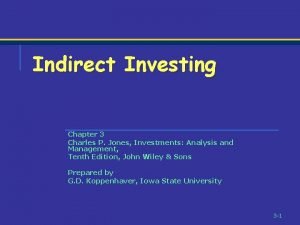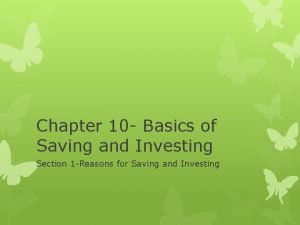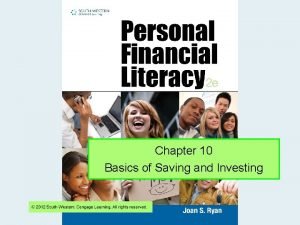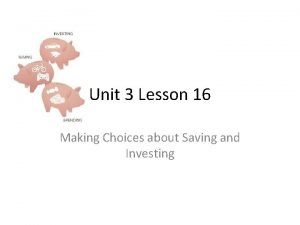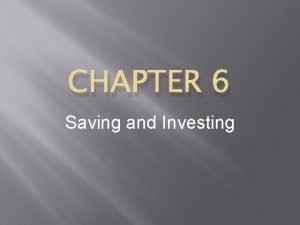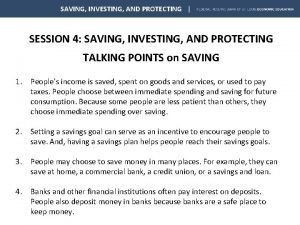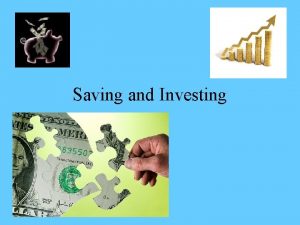SESSION 18 SAVING AND INVESTING Talking Points Saving





- Slides: 5

SESSION 18: SAVING AND INVESTING Talking Points Saving 1. Saving is allocating part of one’s current income toward the purchase of goods and services in the future (i. e. , it is spending on future goods and services). 2. Saving is hard to do because it goes against people’s natural time preference to enjoy benefits now and pay costs later. 3. Saving is good to do because there is a monetary reward: interest (a payment typically based on a percentage of the amount saved).

Session 18: Talking Points, Cont’d Saving 4. The simple interest formula shows how much interest (I) an initial amount of savings (the principal, P) will earn at a fixed interest rate (r) over a specific amount of time (t, usually years): I = prt. 5. The compound interest formula shows how much an initial amount of savings (P) will be worth (A) at the end of some number of years (t) if the annual interest rate is r and n is the number of times interest is compounded during the year: A = P(1 + r–n )nt. 6. Based on compounding, one can determine the number of years it would take an initial amount of savings to double. This doubling can be approximated by the Rule of 72: Time to double = 72/r, where r is the interest rate expressed as a whole number. 7. Because of compounding, the earlier a person starts to save, the greater will be the impact on the amount saved.

Session 18: Talking Points, Cont’d Investing 1. The rate of return on an investment, or asset, over a year is the return (any income generated plus any change in the market value of the asset over the year) divided by the market value of the asset at the beginning of the year. 2. The rate of return on an asset can vary from period to period. 3. The expected rate of return is an average of the actual rates of return over several periods and is typically expressed as an annual rate of return. 4. The greater the variability of the actual rate of return from the expected rate of return, the greater the risk associated with the asset.

Session 18: Talking Points, Cont’d Investing 5. Because people tend to be risk averse (i. e. , they wish to avoid risk), they usually must be paid a higher expected rate of return on riskier assets. 6. Risk can be reduced by a. choosing assets with lower variability, b. time, and/or c. diversification (holding several different types of assets).

Session 18: Talking Points, Cont’d Investing 7. The PACED decision-making model can be applied to the investment decision: a. Problem: The need to choose investments for a portfolio. b. Alternatives: Identify investment alternatives (choices), e. g. , stocks, bonds, mutual funds, savings accounts, and real estate. c. Criteria: Determine which factors to use to evaluate alternatives, e. g. , risk, rate of return, liquidity, costs, and diversification. d. Evaluation: Evaluate the alternatives based on the criteria. Evaluation will vary depending on a person’s age, risk preferences, time horizon, and so on. e. Decision: Choose the highest-ranked alternative given the criteria.
